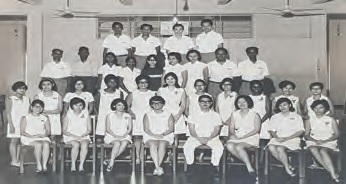The Department of Physiotherapy is the largest in Singapore, providing services across the wide spectrum of clinical specialties.
Physiotherapy at Singapore General Hospital (SGH) is a late bloomer. For over 5,000 years, the Chinese had considered stretching and breathing exercises as vital to health.Meanwhile, Hippocrates (around 460-377 BC), widely accepted as the founder of Western medicine, strongly promoted regular physical activity.
SGH’s Department of Physiotherapy, however, traces its history back a mere 70 odd years. Still, since it was established in 1947, the department has expanded, and matured by leaps and bounds.
In the 1940s, the discipline was already well established in countries such as the UK, Australia, and the US. The importance of physiotherapy services was underscored by rising demand locally — 958 cases in 1949 to 1,458 in 1952, of which most were poliomyelitis patients needing rehabilitation. Before the 1950s, many young polio patients were bedridden.

<< In the 1960s, SGH’s Department of Physiotherapy provided services to other public hospitals.>>
In 1960, Mrs Kathleen Chou was the first Asian to head SGH’s Department of Physiotherapy. She was succeeded by Ms Lim Peck Ngoh in 1964. At the time, SGH physiotherapists provided physiotherapy services to other public hospitals, including Tan Tock Seng and Toa Payoh Hospital (which later merged with Changi Hospital to form the current Changi General Hospital).
In 1989, SGH was restructured and given greater autonomy to run many of its operations, including physiotherapy services. Between 1995 and 2005, the department increased its specialist services to include 24-hour access to services, such as cardiopulmonary, pulmonary, lymphoedema, and vestibular rehabilitation.
Professor Celia Tan was credited with much of the exponential growth when she was department head between 1995 and 2002.
From working mainly with orthopaedic surgeons in the early days, physiotherapists are today invaluable partners in multidisciplinary teams across a wide spectrum of clinical specialties, including paediatrics, neurology, oncology, transplant, burns, rheumatology, emergency medicine, and geriatric medicine.
Physiotherapists continue to serve the community. Dr Dawn Tan, Senior Principal Physiotherapist, trains community partners in Parkinson’s disease therapy so that more people are able to help caregivers and patients in the neighbourhood. Likewise, other physiotherapists volunteer to support community carers for other conditions like cancer and stroke. At public forums, physiotherapists educate, empower and motivate the public to stay fit and healthy. They also conduct fall risk screenings and provide advice.
In the late 1980s, Singapore faced a crucial shortage of physiotherapists, which led four government hospitals to close their outpatient physiotherapy services. SGH was one of two hospitals that retained their physiotherapy services but the department had the highest number of vacancies. Today, the department boasts a staff strength of over 130 physiotherapists and 40 support staff, making it the largest in the country.
About 20 per cent of SGH’s physiotherapists have post-graduate qualifications and are leaders in their respective specialties. Many teach in local and overseas tertiary institutions. Dr Pua Yong Hao, Senior Principal Physiotherapist, won the 2019 National Medical Research Council Transition Award, which highlights the department’s commitment to improve clinical outcomes through research.
As the population ages, the department anticipates an increase in demand for therapy, and is looking to improve and optimise staff skills and work processes. Importantly, to attract and retain staff, it introduced a residency programme in 2013. And in 2015, a programme that lays out a clear career pathway to show how staff can advance and develop professionally — be it in clinical care, teaching, research, or management — was launched.
